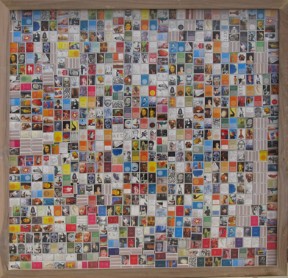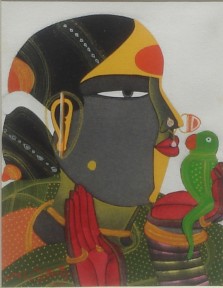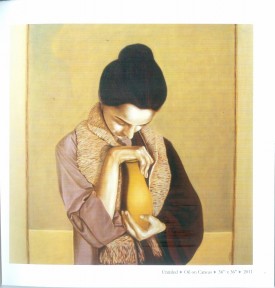If you are not out travelling to escape the Delhi heat, then it is time to indulge yourself in some of the choicest art that the city galleries have on offer. While earlier, a group art show during the traditional ‘off’ season was usually considered banal – as most galleries would merely put out their store room inventory till the season began in July-August – summers are no longer dull and boring for an art lover. We select for you the three best group shows that have an eclectic mix of art ranging from paintings, drawings, sculptures and installations.
THE ANNUAL
AT LATITUDE 28, LADO SARAI,
NEW DELHI
ON TILL JUNE 15, 2011
The Annual, as the name suggests, is the second anniversary show of the gallery that has positioned itself nicely in its two-year-old journey as promoter of both senior and young contemporary artists. The show has art by veterans like Arpana Caur, Anupam Sud, Jogen Chowdhury, Bose Krishnamachari, Baiju Parthan, Paresh Maity, Jaysree Burman, Seema Kohli and younger artists like Abir Karmakar, G R. Iranna, George Martin, Prajakta Palav, Rajesh Ram, Prajjwal Choudhury and Anjaneyulu G.
Arpana Caur, a self-taught artist who has been greatly influenced by her mother and author Ajeet Cour, uses the female form for figurative works that exude a quiet authority. Her contemporary Anupam Sud, one of the finest printmakers in India, creates a similar statement through firmly etched human figures that draw our attention to psychological tensions between man and woman.
Known for his overt rendition of alternate sexuality using self-portraiture, Abir Karmakar’s work are provocative and personal while Baiju Barthan, known as a pioneer of inter-media art in India, elaborates on the workings of a mysterious inner universe through his paintings.
George Martin’s abstract work is a spectrum of luscious colours exuberating copious amounts of energy and becomes an ultimate representation of modern urban life, while his contemporary G R Iranna depicts an idealistic and modernist language of Indian contemporary art transcending the boundaries of time and space.
Jaysree Burman works mainly in watercolor, using rich strong hues and bold themes with a mythic element – strange hybrid animals with human heads and female figures. The imagery in Burman’s work has a dream-like and lyrical quality with a unique sensitivity which, although inspired by the Indian folk element, retains a quality of refreshing candour and reflective honesty, that is as original as it is endearing.
Even the younger artists in the show have produced works of great quality. Mumbai’s Prajakta Palav paints every detail from a multitude of photographic references that she has archived over the years. The candid medium of photography allows her to unpretentiously penetrate the many aspects of middle class life in India and capture its varied truths. A young and promising artist Rajesh Ram, who is both a painter and a sculptor, uses a strong visual vocabulary that builds on pointed references – in this show the sculpture is about bonded labour.
UBW recommends: Prajjwal Choudhury’s sculptural installations depicting the ‘ugliness’ of consumerist mentality through formal beauty. Choudhury is at war with the way in which everyday objects are taken for granted and so easily discarded. Objects such as matchboxes and bottles, which he has been mostly consumed with – are mass produced, used and discarded – and it is here that Choudhury gathers the preliminary fuel to engineer his thought-provoking creations.
PRELUDE IN SUMMER
AT DHOOMIMAL CITY GALLERY, BELOW SAFDARJUNG FLYOVER,
NEW DELHI
ON TILL JUNE 30
The gallery has chosen four noted artists from the South – Thota Vaikuntam, Laxma Goud, Laxman Aelay and Chippa Sudhakar – for this show. The exhibition comprises of thirty artworks, united in their diverse artistic creations.
Former signboard painter Laxman Aelay’s paintings are nostalgic, depicting the rural people he grew up with. His source of inspiration has been the lives of poverty stricken people from his village – Kadirenigudem. Recently, Aelay has switched over from using white, black and shades of grey, which he preferred in his paintings, to using vivid colours to depict flowers, jewellery and traditional clothing. His latest works are much smaller and compact.
Artist Chippa Sudhakar’s works have a distinct touch of folk art. He executes his fantasies on wood, combining the art of laying colour, with that of carving. Primarily based on the intricate relationship patterns between men and women, Sudhakar’s paintings attempt to explore the nuances of these subtle links. Another of his favourite subjects is a dream; water too is an ever-present factor, in the form of rain, streams, boats and fish, a faithful recreation of the reality of village life. Because of the nature of the materials he works with, he uses natural colours whenever possible. Sepia, ochre, black and beige, in acrylic, are the dominant hues utilised to paint out the figures that he fashions from the plank itself. Metals, such as copper attached with wires, provide a contrasting element of colour as well as texture, relieving the eye from the preponderance of wood.
The show also has works by renowned artist Laxma Goud, a master draftsman, who displays his versatility over a range of mediums, from etching, gouache and pastels, to sculptures. Over the years he is known to have moved from one medium to another with great ease. Rustic, raw, potent are the words that come to mind when looking at Goud’s works. Portraits of men and women represent the dynamic Indian ethos rather than particular individual identities. The power of his lines in black and white or in colour is eloquent in its expression. A recurrent theme with Goud is that of the erotic, treated as an active and powerful aspect of male and female sexuality. In his world, the tree spirits and those of the animal kingdom amalgamate to create a new fantasy.
UBW Recommends: While Thota Vaikuntam’s paintings have always captured simple lifestyle of villagers like paddy fields, household chores, temple rituals, with works ranging from stark charcoals on paper to transparent washes and pencil drawings, this exhibition features Vaikuntam’s trademark works of elaborately dressed men and women from the Telangana region. His muse is the sensuous and voluptuous woman of Telengana with her omnipresent vermilion bindi, draped in colourful sarees that highlight their dusky skin.
CROSS CURRENTS
AT ART POSITIVE, LADO SARAI,
NEW DELHI
ON TILL JUNE 15
Here is another show which is an ensemble of creative expressions by four artists. There are cross-currents and connections running through their aesthetics but some elements seem to thread them together in this collective display under one roof despite the disparate context and approach of each artist.
The artists represent four different schools of art and thought. Delhi based S. Harsha Vardhana, a trained bio-scientist and a self taught artist who comes from an artistic lineage, works in an abstract mode, rarely giving titles or meaning to his work. The focus for him is the synergy in his imagery and not in the details. His paintings, on canvas and paper, use textural geometrical forms, inverted triangles, lines and markings criss-crossing each other almost like musical notations and ancient symbols.
Kolkata’s Chandra Bhattacharjee, who comes from rural Bengal and has trained at the art college in the city, breaks free from his Bengal school baggage though retaining something of its air in his haunting narratives that seem lined with melancholy in their underbelly. Bhattacharjee turns a storyteller in an autobiographical stance, to articulate his unhappiness with the ways of the world today. The complex mechanisms and machines that are put in place to regulate things and make life easier soon begin to invade and start to run over man turning him redundant. There is a collection of canvas and paper paintings in varied sizes where his figuration surrounded by other forms appears pensive in his trademark subtle palette with a rich textural quality.
C.F John, who lives and works in Bangalore, showcases a philosophical frame of mind while Somu Desai, born and brought up in a Gujarat village and now working in Mumbai, uses his background in fashion design and mural making to create art that is mixed-media driven and rooted in technology. His canvases are inspired by construction sites dotted all over urban metros with their over arched structures in progress through architectural drawings and translucent human figures. He is someone who enjoys making his kind of art in most mundane derelict spaces and abundant factories.
Despite their heterogeneous expressions and engagement with individual styles and choice of medium, form, size and ideation, the artists seem to bond together well in a certain democratic way. The exhibition as a springboard for self expression is a shared platform for the artists.
UBW Recommends: C F John’s untitled oil on canvas, that stands out for its serene palette and love for nature. His work, be it as paintings or video art is mission driven and resonates the fast paced changes that are not only impacting society but also the environment. With thematic underlining of issues about urban life, struggles encountered by the lesser privileged communities and the influential mechanism of control, John as an art activist perceives art not only for art’s sake but also as a tool for wider communication and reach.








